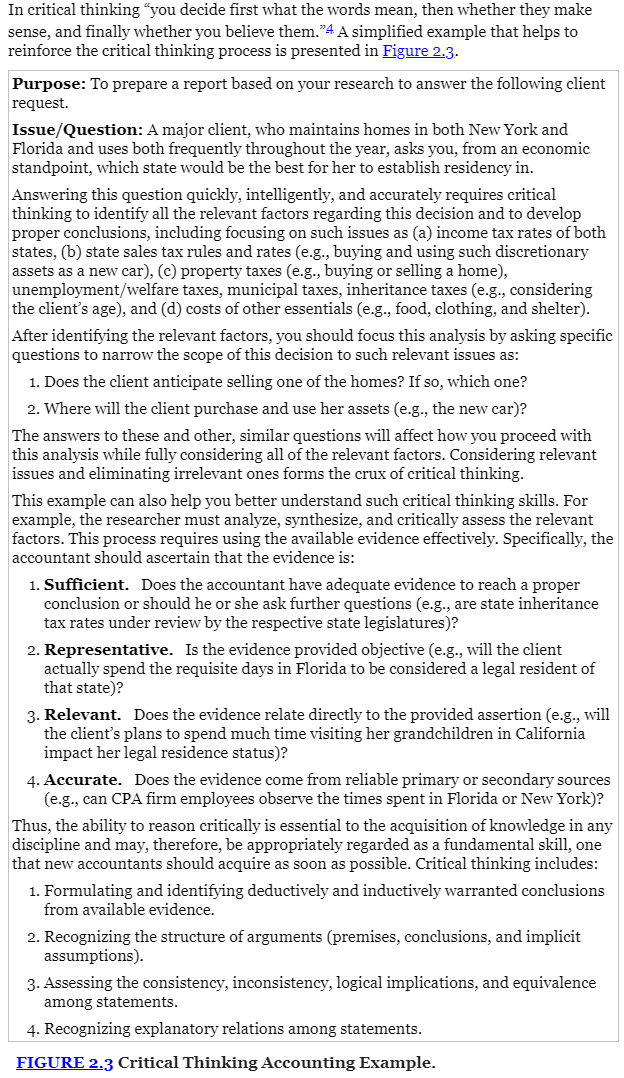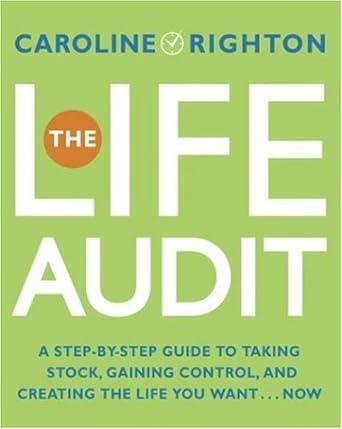Utilizing Figure 2.3 (Eight Elements of Reasoning), develop the eight elements for the following issue: Daimler Auto Parts, Inc., headquartered in Munich, Germany, is attempting to register with the SEC in order to list its stock on the New York Stock Exchange. Daimler currently is capitalizing most of its research and development (R&D) costs. Management of Daimler has requested your advice in regards to the proper accounting for R&D as to conformity with U.S. GAAP and/or International Accounting Standards.

In critical thinking "you decide first what the words mean, then whether they make sense, and finally whether you believe them."4 A simplified example that helps to reinforce the critical thinking process is presented in Figure 2.3. Purpose: To prepare a report based on your research to answer the following client request. Issue/Question: A major client, who maintains homes in both New York and Florida and uses both frequently throughout the year, asks you, from an economic standpoint, which state would be the best for her to establish residency in. Answering this question quickly, intelligently, and accurately requires critical thinking to identify all the relevant factors regarding this decision and to develop proper conclusions, including focusing on such issues as (a) income tax rates of both states, (b) state sales tax rules and rates (e.g., buying and using such discretionary assets as a new car), (C) property taxes (e.g., buying or selling a home), unemployment/welfare taxes, municipal taxes, inheritance taxes (e.g., considering the client's age), and (d) costs of other essentials (e.g., food, clothing, and shelter). After identifying the relevant factors, you should focus this analysis by asking specific questions to narrow the scope of this decision to such relevant issues as: 1. Does the client anticipate selling one of the homes? If so, which one? 2. Where will the client purchase and use her assets (e.g., the new car)? The answers to these and other, similar questions will affect how you proceed with this analysis while fully considering all of the relevant factors. Considering relevant issues and eliminating irrelevant ones forms the crux of critical thinking. This example can also help you better understand such critical thinking skills. For example, the researcher must analyze, synthesize, and critically assess the relevant factors. This process requires using the available evidence effectively. Specifically, the accountant should ascertain that the evidence is: 1. Sufficient. Does the accountant have adequate evidence to reach a proper conclusion or should he or she ask further questions (e.g., are state inheritance tax rates under review by the respective state legislatures)? 2. Representative. Is the evidence provided objective (e.g., will the client actually spend the requisite days in Florida to be considered a legal resident of that state)? 3. Relevant. Does the evidence relate directly to the provided assertion (e.g., will the client's plans to spend much time visiting her grandchildren in California impact her legal residence status)? 4. Accurate. Does the evidence come from reliable primary or secondary sources (e.g., can CPA firm employees observe the times spent in Florida or New York)? Thus, the ability to reason critically is essential to the acquisition of knowledge in any discipline and may, therefore, be appropriately regarded as a fundamental skill, one that new accountants should acquire as soon as possible. Critical thinking includes: 1. Formulating and identifying deductively and inductively warranted conclusions from available evidence. 2. Recognizing the structure of arguments (premises, conclusions, and implicit assumptions). 3. Assessing the consistency, inconsistency, logical implications, and equivalence among statements. 4. Recognizing explanatory relations among statements. FIGURE 2.3 Critical Thinking Accounting Example







